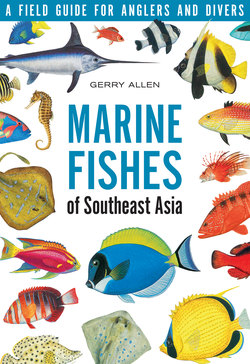Читать книгу Marine Fishes of South-East Asia - Gerry Allen - Страница 20
На сайте Литреса книга снята с продажи.
ОглавлениеHOW TO USE
THIS BOOK
This book is designed as a pictorial guide that relies on visual comparison between the painted illustrations and actual specimens, photographs, or underwater observations. Distinguishing features are highlighted in the text accompanying each plate, in most cases referring to colour pattern or the shape of the body or fins. These features are useful for differentiating the species in question from its close relatives, or species it is likely to be confused with. A guide to families based on outline drawings precedes the species section. When attempting to place a fish in the proper family particular attention should be given to the head and body shape, number of dorsal fins, placement of fins and their positions relative to one another, and presence or absence of spiny elements in dorsal and anal fins in particular. The use of technical scientific words is deliberately avoided, but a few terms relating to the external features of fishes are useful for identification and are illustrated below.
Each species account appearing on the page opposite the corresponding plate includes the common name and scientific name followed by the name of the person who first described it and the date of description. If the person’s name appears in parentheses it indicates that the species was originally placed in a genus different from its presently recognised one.
Common names are invariably contentious in that species that range widely often have several common names according to locality. This problem is greatly compounded in South-east Asia because of the huge number of languages and dialects spoken. Because of this problem, it is unfortunately not possible to use local names. Therefore Australian common names are utilised. The basis for many of these is Munro’s Fishes of New Guinea, Marshall’s Fishes of the Great Barrier Reef Allen and Swainston’s Marine Fishes of North-Western Australia, and Randall, Allen, and Steene’s Fishes of the Great Barrier Reef and Coral Sea.
The text for each species contains general information on habitat, feeding habits, distinguishing features, and geographic distribution. Several of the distributional terms need to be explained in more detail. Indo-E. Pacific refers to a distribution that extends from East Africa to the Americas; E. Indian Ocean and W. Pacific is generally from the Maldives eastward to the western fringe of the Pacific, including Micronesia and Melanesia; W. and C. Pacific refers to the area encompassing the western fringe of the Pacific from Japan to Australia and extending eastward to embrace much of Oceania, often to Samoa, Tuamotus, or Society Islands south of the equator, and the Line Islands (and sometimes Hawaii) north of the equator; Indo-Australian Archipelago embraces the region including the Malay Peninsula, Indonesia, Philippines, northern Australia, and the islands of Melanesia.
The maximum known total length, measured from snout tip to the end of the tail is given at the end of each species account and for a few exceptionally large fishes the maximum recorded weight is also given. I have purposely omitted information on relative abundance (i.e., common, rare, etc.) as this parameter is subject to considerable local variation depending on availability of suitable habitat and in the case of migratory species, the time of year.
In addition to the individual species accounts, ‘boxes’ of text are included for most plates which contain general information for families, pertaining to such topics as number of species worldwide, ecology including food habits, and any noteworthy behavioural or morphological characteristics.
Figure 2. Diagram of a ‘typical’ fish showing external features.
